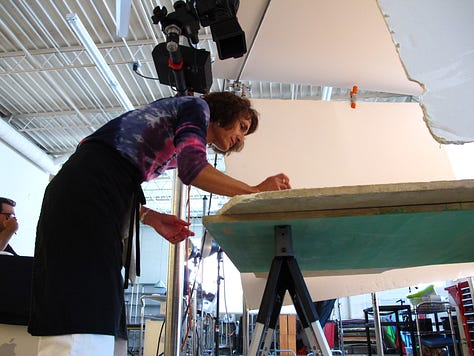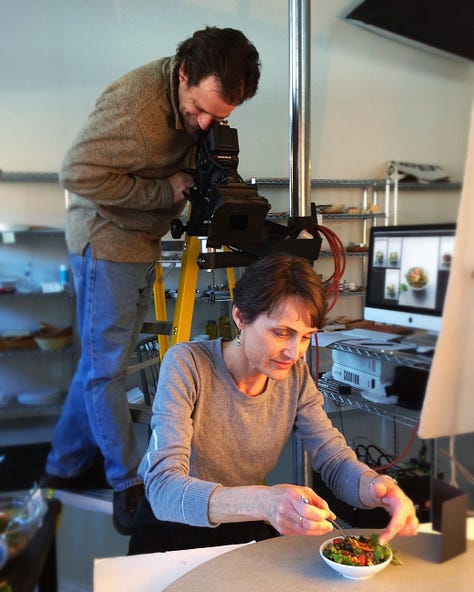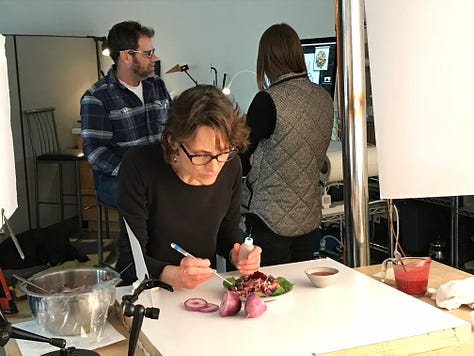
A gin & tonic or a really good Margarita? The sometimes rewards for a job well done—or a client that’s ready for fun. Studio life is pretty grand—wearing jeans to work every day? Sitting down for long communal lunches, escaping the drudgery of desk work? Reflections of years past, when working in photo studios (always hard and more physical work than you’d think) had a glamorous sheen. These days the behind-the-scenes of food shoots are focused, often on Zoom, and hardly glamorous. Clients found during Covid that they could communicate pretty effectively virtually—and the habit has stuck. Leaving studio teams more often than not on their own. I think in some ways our work, despite many fewer Happy Hours, is easier than the song-and-dance of everyone from an agency showing up for those communal (and free) lunches.
I’ve had my own freelance business, working commercially, as a food stylist and food “consultant” (whatever that means) for a very long time. When asked what I do, my first reaction is “what day is it?” I know, sort of cliché, but consultant is just a word that means Jack (or Jill)-of-all-trades. And food styling is still a curious & kinda romanticized way to make money.
I ended up in the food world after a serious pivot in college, where I was a virtuous (I thought I wanted to do medical research) but reluctant chemistry major. But my unconscious love—a centering, gravitational pull—was always in the kitchen. And a mother’s good advice redirected me to nutrition & food science. And an eventual diploma from a French cooking school. But it was my time in corporate food test kitchens (those now dinosaurs) that cemented my place in the world of food photography. I recognize how lucky I’ve been—there are few places any more with mentoring for the art—and often craft—of food styling. A few big publishers and businesses that rely on lots of recipes & photography (Target, General Mills, Best Buy & a few other retailers in my marketplace) still have in-house studios & test kitchens that can be training grounds. But mostly today is all about learning on the job. And as much as online content creators claim they’re food photographers & food stylists, creating imagery for advertising is a whole different animal from shooting your own work with a phone camera (I’m not knocking that—I do it all the time for this newsletter!) But advertising is still where most of the bucks are, unless you can spin a blog with reliable advertising or write a really great Substack with an impressively large—and paying—audience. Eyeballs still rule.



So, when I call myself a food stylist, I’m swimming in the commercial ocean—where we’re shamelessly selling stuff. Food packaging, television (and now video & streaming) ads, web site recipes pushing branded products…this is the ecosystem I’ve been bobbing in (sometimes needing a life jacket) for a long time. Along the way I’ve made decisions to work with great food shooters (no, I do not take the photos when working with a client), develop recipes for real cooks, and write quite eclectically about food/eating/cooking whatever obsesses me in the moment. I’ve also had the great good fortune to write a few cookbooks of my own + style the photos—the stuff of dreams as I deconstruct a frozen entrée for a packaging shoot. My official job is as chief shopper, dish washer, and cooker of the food on the set—that I must keep looking freshly made, no matter how long it might have to wait for its close up. My sense of style is my stock in trade.
Food styling and what it means has shifted— “random” perfection, food “noise” (spills, crumbs, ground pepper or coarse salt spilling onto surfaces), food that is just more approachable—freshly made, calling everyone in to eat. Style changes & the looks of photos go in and out of vogue (vintage flatware & Grandma’s plates vs. sleek, modern and shot overhead). But personal style, and how you connect with people who see your food before eating it, can’t be learned. Good styling—or cooks who make & share food in a seeming less effortless way—is a way of thinking. I always have pictures in my head—color, texture, shape, and size—concepts that are more about artfulness than anything. But then flavor, both visually and for real, must join the fray in the process of planning a menu. As I ruminate about even the most basic dinner, I make decisions based on balance & contrast. Seasonality of ingredients, availability, budget, diner (or your family’s) preferences, and what tastes good to you…lots flowing simultaneously as you shop, cook, and share. How I visualize food really informs my recipe work, too.
Tomorrow I’m diving into my first Substack LIVE—dipping my toe in as a guest on Rebecca Blackwell’s Let’s Get Lost. We plan to chat about how my styling years have influenced how I share food in real life. And I’ll do a fast demo of a summer platter of roasted or grilled vegetables, chicken, and a garlicky mayo, inspired by a French classic—a Grand Aïoli. Plus take questions from any of you who can join us—we’ll keep the time commitment short, but fun. Here’s a loose recipe—as noted for you renegade cooking types, feel liberated to buy whatever you find in the market now. Grilled chicken is an easy sell, but anything goes.

If you’re at all interested in reading some case studies of client assignments I’ve worked on, click here.
GRILLED CHICKEN PAILLARDS LE GRAND AïOLI
Makes 8 servings
If you prefer dark meat, use boneless skinless thighs that are pounded out to an even thickness so they grill quickly. Aïoli is really nothing more than a thick, aromatic garlic mayonnaise and is the heart of midsummer celebrations of seasonal vegetables in southern France. Here the mayo is made with roasted garlic and fresh herbs—the perfect sauce for grilled chicken.
AIOLI
16 cloves roasted garlic (from a grocery store olive bar or roasting a whole head, wrapped in foil, in the oven or on the grill)
¼ cup sprigs/leaves fresh flat-leaf parsley or tarragon
Coarse salt to taste
3 large pasteurized egg yolks
1-1/2 cups lightly flavored extra-virgin olive oil
3 tablespoons fresh lemon juice
CHICKEN
4 large (2 pounds) boneless, skinless chicken breasts
2 tablespoons olive oil
2 teaspoons dried herbes de Provence
Coarse salt and freshly ground pepper to taste
VEGETABLES*
1 lb. fresh asparagus, grilled or steamed
8 small artichokes, trimmed and steamed, cut in half vertically and choke removed
½ pound green beans, steamed
4 medium red, golden, and/or chiogga beets, sliced or quartered and steamed
12 small radishes, with tops
6 hard-cooked eggs, peeled and halved
1 can (15 ounces) cooked garbanzo beans, rinsed and drained
Fresh garden herbs, as desired
DIRECTIONS
1. Heat grill to medium heat. To make aïoli, place garlic and herbs in a mini chopper or blender with a dash of salt. Process until smooth. Add egg yolks; process until blended. Slowly start adding the oil with the motor running until the mixture is thick and glossy. Add the lemon juice and process another few seconds until the mayonnaise is smooth. Set aside.
2. Cut chicken breasts horizontally into thin cutlets (paillards). Brush with oil and season both sides of each cutlet with herbs de Provence, salt, and pepper.
3. Grill the chicken for about 3 minutes, turning once, until no longer pink in center.
4. Spoon the aïoli in a bowl and place it on a large platter or tray. Surround the bowl with the chicken, vegetables, hard-cooked eggs, and garbanzo beans. Garnish the platter with fresh herbs.
*Feel free to substitute other favorite summer vegetables for the ones suggested, for example fresh fennel, small carrots with tops, cherry tomatoes, roasted sweet bell peppers, baby carrots, sugar snap peas, or tiny fingerling potatoes. It’s fine to mix up how they are prepared—raw, steamed, or grilled.




